Team chemistry | FUT
A good team line-up in the Ultimate Team mode is only the first step to success. Creating it is not easy, as there are numerous factors to keep in mind, including team chemistry, formations, balance etc. What is extremely important is the selection of players. Overall rating does not reflect whether the player is a good one to have in FIFA. You can find the most important information about creating the right line-up in this chapter.
To harness the full extent of your players' potential they must have maximum chemistry. The chemistry for a single player can reach a maximum value of 10. It depends on the chemistry links between players, as well as the player's position. In this chapter you will learn how to create a team with excellent chemistry.
- Chemistry in relation to positins
- Chemistry between players
- Calculating chemistry
- The effects of chemistry
- The manager
- Position Change Cards
Chemistry in relation to positins
The first thing you need to do to make sure the player has maximum chemistry is to put him it in the correct position. The position of each player is shown on his card. There are 17 available positions in the game: goalkeeper, left/right back, left/right wing back, centre back, centre defensive midfielder, centre midfielder, centre attacking midfielder, left/right midfielder, left/right winger, centre forward, left/right forward and striker.
Of course, different formations have different positions. For example, the attack of a formation can consist of strikers only, while others can utilize a centre forward with wingers. That's why you need to choose the appropriate formation for your players. You cannot grant the basic version of Ronaldo full chemistry if he appears as a left winger in a 4-1-2-1-2 formation, even if you use a position change card, which we will discuss further in another chapter.
If a player has appropriate connections with the rest of the composition (you will learn more about chemistry links in the following chapter), he will have 10 chemistry only when he has been correctly positioned in the formation. However, if he occupies a position similar to his original one he will receive 9 chemistry points. That should prove sufficient for your needs, as the difference of a single point is nearly indistinguishable. For example, Ronaldo in the LW position will have 9 chemistry if he is positioned as a left midfielder or left striker in the line-up. However, if he were to occupy a right winger position, it would result in him having only 6 chemistry. All of the above is based on the assumption that he has full chemistry with the rest of his teammates.
Here are the charts depicting the chemistry of players in relation to their position:
S | CF | LF | RF | LW | RW | LM | RM | |
S | 10 | 9 | 6 | 6 | 3 | 3 | 2 | 2 |
CF | 9 | 10 | 6 | 6 | 3 | 3 | 2 | 2 |
LF | 6 | 3 | 10 | 6 | 9 | 3 | 6 | 3 |
RF | 6 | 3 | 6 | 10 | 3 | 9 | 3 | 6 |
LW | 3 | 3 | 9 | 3 | 10 | 6 | 9 | 3 |
RW | 3 | 3 | 3 | 9 | 6 | 10 | 3 | 9 |
LM | 3 | 3 | 6 | 3 | 9 | 3 | 10 | 6 |
RM | 3 | 3 | 3 | 6 | 3 | 9 | 6 | 10 |
CF | RM/LM | CAM | CM | CDM | CB | |
CF | 10 | 3 | 9 | 3 | 3 | 3 |
RM/LM | 3 | 10 | 3 | 6 | 3 | 3 |
CAM | 9 | 3 | 10 | 9 | 3 | 3 |
CM | 3 | 6 | 9 | 10 | 9 | 3 |
CDM | 3 | 3 | 3 | 9 | 10 | 6 |
CB | 3 | 3 | 3 | 3 | 6 | 10 |
RB | LB | RWB | LWB | CB | RM* | RW* | |
RB | 10 | 6 | 9 | 3 | 6 | 6 | 3 |
LB | 6 | 10 | 3 | 9 | 6 | 3 | 3 |
RWB | 9 | 3 | 10 | 6 | 3 | 6 | 6 |
LWB | 3 | 9 | 6 | 10 | 3 | 3 | 3 |
CB | 6 | 6 | 3 | 3 | 10 | 3 | 3 |
RM* | 6 | 3 | 6 | 3 | 3 | 10 | 9 |
RW* | 3 | 3 | 6 | 3 | 3 | 9 | 10 |
*LM and LW follow the same principle, only in an inverted fashion
All of the settings which have not been listed grant the player either 2 or 3 chemistry points.
Chemistry between players
In every team the players in specific positions are connected to each other. Between them you will see red, orange or green connections. For a player to have full chemistry, he must be surrounded by players that he gets along with.
The player needs as many points as there are connections in the formation going out of his position. It depends strictly on the formation. For example, in the 4-1-2-1-2 formation the CAM needs as many as five points to have maximum chemistry, while the left and right backs only need two.
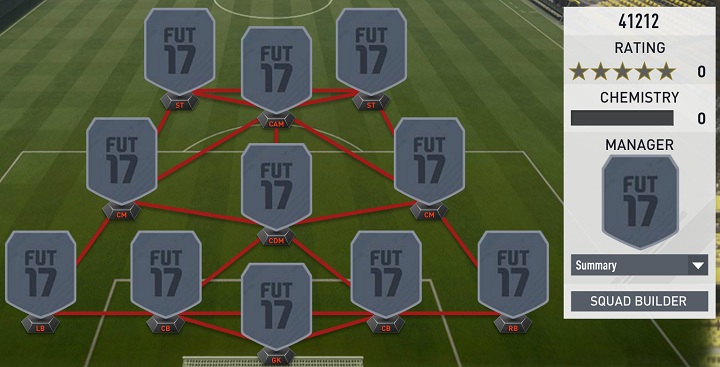
The player receives chemistry points from another player if:
They play in the same league, but in a different club and have a different nationality - 1 point
They play in a different league, but they are of the same nationality - 1 point
They play in the same league, in different clubs, but they are of the same nationality - 2 points,
They play in the same club, but are of different nationalities - 2 points,
They play in the same club and are of the same nationality - 3 points
If a player lacks chemistry with another player, the connection between them is red; if they have a single point of chemistry, then it becomes orange; 2 or 3 chemistry points are represented by a green connection.
The following are examples of teams with maximum chemistry. As you can see, some have a lot of red connections, while others do not have any, and yet they all have full chemistry.
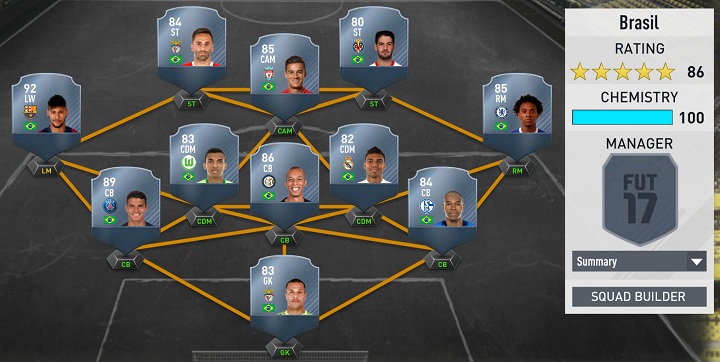
In this line-up, all of the players are of the same nationality. This is an example of a team with full chemistry, despite the complete lack of green connections.
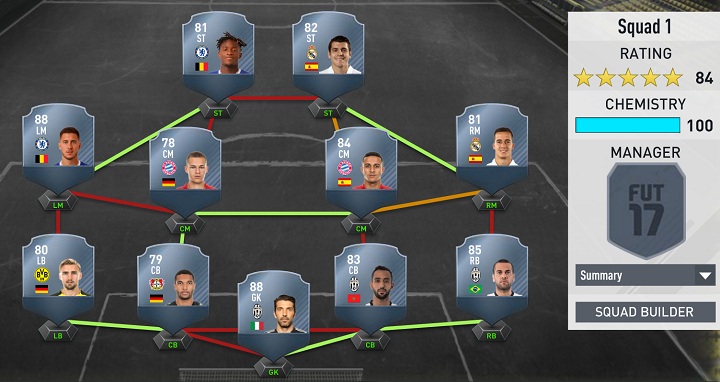
This team also has 100 chemistry, and each player a total of 10. Mostly green links are utilized here, as well as the perfect connection between Hazad and Batshuayi.
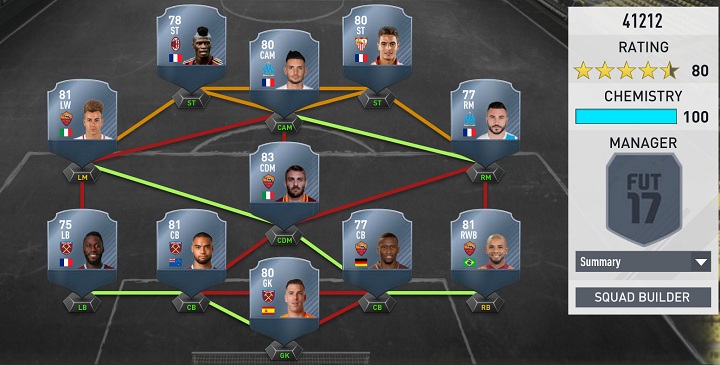
This line-up also has maximum chemistry (only Bruno Peres has 9, due to the RWB being on a RB position, but you can give him a position change card).
Calculating chemistry
If you have followed the instructions of the last two chapters correctly, your players will have a chemistry score of 10 points. However, this is not a value that defines their final statistics. Some calculations are still required.
A player from the main squad
What affects him is 25% of the overall chemistry value of his team and 75% of his own chemistry. Therefore, we arrive at the following formula:
((Chemistry value of the team) * 0.25) + ((Chemistry value of the player * 10) * 0.75)
If the chemistry of the team has a value of 100 and the player a value of 10, then we get the following value:
100*0.25+10*10*0.75=
25+75=
100(99)
Substitute players
For a substitute player, 25% of the team chemistry value and 75% of his own chemistry value also apply. However, the chemistry value of any substitute player is always 5, regardless of the position he will occupy after coming onto the pitch. The formula is the following:
((Chemistry value of the team) * 0.25) + ((Chemistry value of the player * 10) * 0.75)
If your team has a chemistry value of 100, than the player's final value is equal to:
100*0.25+5*10*0.75=
25+37.5=
62.5
Changing the formation or position of the players during the game does not change the chemistry.
The effects of chemistry
If a player has a chemistry value of 50, then he has exactly the same statistics during the match as those on his card. Each point below 50 lowers his skill, and at 0 chemistry, all statistics are reduced by 25. Each point above 50 improves specific abilities either by 5, 10 or 15, depending on the play style that the player received. However, the maximum value of any skill is 99.
Below you will find a link to a chart that shows the changes in the statistics of a player at maximum chemistry.
https://docs.google.com/spreadsheets/d/1hs6p-ur6JQfJSxLI37iaWV6bUqgwd6LC6y6Y1tQEwV8/pubhtml
The manager
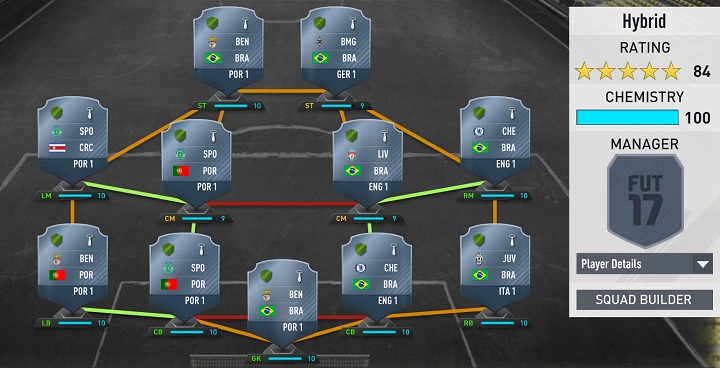
Managers are a part of the squad to add chemistry points to specific players and extend their contracts. Each of them has a specific league and nationality. A manager's league can be changed by using a Manager's League card.
A manager adds one chemistry point to players from the same league or the same nationality. It cannot, however, give two points to the same player.
In a situation similar to the one shown in the picture above, where the three players have 9 chemistry due to bad positioning, it would be more efficient to buy a manager rather than three Position Change cards. Half of the sample composition is from the Portuguese league, and the other half are Brazilians. What to do in a situation when the league does not have a Brazilian coach? Purchase a cheap Brazilian coach and change his league with a Manager's League card. Thanks to that, all of the players in this particular line-up will receive a bonus to chemistry.
Position Change Cards
Possible position changes in FIFA 17:
RB-RWB, RWB-RB,
LB-LWB, LWB-LB
RM-RW-RF*, RF-RW-RM*
LM-LW-LF*, LF-LW-LM*
CDM-CM-CAM-CF-S*, S-CF-CAM-CM-CDM*.
* The positions need to be changed in order, if you want to change a left forward to a left midfielder, you must first use the LF>LW card and then the LW>LM card. There is no LF>LM card.
You are not permitted to copy any image, text or info from this page. This site is not associated with and/or endorsed by the Electronic Arts Inc. or EA Sports. All logos and images are copyrighted by their respective owners.
Copyright © 2000 - 2025 Webedia Polska SA for gamepressure.com, unofficial game guides, walkthroughs, secrets, game tips, maps & strategies for top games.
